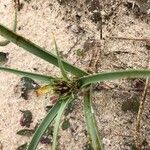Perennial herb, 0.1-0.6 m high, long-rhizomatous or ± tufted. Leaf blades very short, rigid. Culm scapose, subterete, 2-3 mm in diam. at middle. Inflorescence appearing lateral, ± 10-30 x ± 8-30 mm, a digitate cluster of (l-)several spikelets. Subtending bract erect, rigid, longer than inflorescence. Spikelets ± compressed, linear to lanceolate, 5-20 x 1.5-3.0 mm, straight or curved. Glumes very closely imbricate, broadly elliptic, 2.0-3.5 mm long, light brown or purplish. Flowering time Oct.-Dec. Nutlet with plane face against rachilla, obovate, 1.5-1.7 x 0.8-1.0 mm, plano-convex, grey to brown, surface smooth.
Perennial herb, up to 0.6 m high; tufted or rhizomatous; culms crowded or solitary on a long, creeping rhizome. Leaf blades very short, rigid, reduced to sheaths. Flowers: inflorescence appearing lateral, ± 10-20(-30) x ± 8-20(-30) mm, a digitate cluster of (1-)several spikelets, overtopped by largest, erect and rigid basal bract; spikelets 2.0-2.5 mm wide; glumes and nutlets abscising individually leaving a persistent rachilla; style branches 2; glumes many per spikelet, light brown or purplish; Oct.-Apr.
Rhizomatous or tufted, erect perennial, 100-600 mm tall. Leaf blades very short, rigid. Stem cylindrical, 2-3 mm diam. at middle. Inflorescence appearing lateral, ± 10-20(-30) x ± 8-20(-30) mm, a digitate cluster of (1-)several spikelets, overtopped by the largest, erect, and rigid basal bract. Spikelets 2-2.5 mm wide, light brown or purplish.
A tufted, perennial herb, up to 0.6 m high. Culms crowded or solitary on a long, creeping rhizome. Inflorescence a solitary spikelet or a loose to crowded head of spikelets, lateral. Glumes pale yellowish grey.
A sedge. It grows 60 cm high. It keeps growing from year to year and can form clumps connected by an underground stem. The flowering shoot has a small array of cylinder shaped spikelets.
Constantly with an erect bract and a capitate, pseudo-lateral inflorescence of sessile, white spikelets
Rhizomatous to tufted perennial, 10-60 cm. Spikelets light brown or purplish.
A creeping, rush-like sedge, varying much in size


